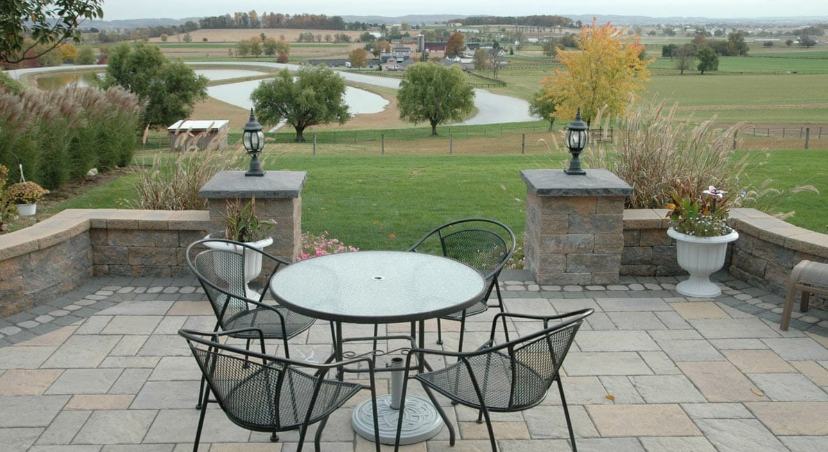
Enhancing your outdoor living space will add functionality and value to your home. Steps, pathways, retaining walls, and patios— all known as “hardscapes”— add dimension, texture, and “curb appeal” to houses of all kinds.
Adding a patio is an especially good choice for enhancing your outdoor living space. The material you choose for your patio should both look the way you want and perform the way you need it to. Do you want a sleek modern look? Perhaps rustic elegance is more your taste? Check through Pinterest and magazines to get an idea of looks that appeal to you, and that complement your home and its surroundings. You’ll also want to keep in mind which materials hold up better in certain climates, how easy they are to maintain, and how conducive they are to your family’s lifestyle.
Let’s do a quick review of your options:
Concrete
Some consider it plain and low-end, but basic concrete makes a relatively inexpensive, durable, and versatile patio material. If you want something more modern with a distinctly upscale vibe, there are finishing processes for poured concrete that lend it the look of more expensive materials like flagstone or brick. Keep in mind, however, that concrete is prone to cracking in very cold climates. When combined with low temperatures and moisture, the surface can also develop “efflorescence”, a whitish residue that will need to be scrubbed or power-washed to avoid permanent discoloration. Special textures and tints are less durable than the poured concrete substrate, so plan on refinishing them every few years.
Natural Stone
The beautiful textures and irregular shapes of natural stones like slate, sandstone, granite, and limestone are an enduring choice for outdoor patios. Cost associated with quarrying, transportation, and installation make it one of the more expensive options, but the overall effect is earthy and sophisticated, not to mention unique and high-end. Keep in mind that building a patio of natural stone is not a DIY project— professional installation is an absolute must. Even with professional installation, natural stone patios may show variances in texture, color, and thickness, and may have a tendency to crack and etch.
Brick
Bricks are manufactured in a wide variety of colors and finishes, and can be laid in circular, basketweave, herringbone, or other patterns. The combination of color, finish, and pattern create vastly different looks. Consider a professional bricklayer for this type of patio as well— you’ll be able to count on your installer to resolve any drainage issues and carefully prepare the area before laying the brick. Plan on cleaning and sealing the brick every 2–3 years to maintain its beauty and durability.
Porcelain Pavers
Porcelain pavers are a newer option for building patterns that are becoming increasingly popular. Not only are they beautiful and versatile, porcelain pavers are non-porous, durable, weather-resistant, eco-friendly, and easy to clean and install. Most importantly, they are beautiful and can complement almost any existing look. Porcelain pavers retain the natural look of slate, granite, or sandstone without the permeability, unevenness, or difficulty of installation of quarried stone. They are UV, scratch and skid resistant, and don’t require special upkeep— they do not need to be sealed, and a light wash with regular household cleaner will keep them looking new for many years.
Concrete Pavers
Concrete pavers offer a wide range of colors, shapes, and textures, and are easier to install than poured concrete. Do-it-yourselfers will like their interlocking design, which eliminates the cracking that often occurs in freeze/thaw environments.
